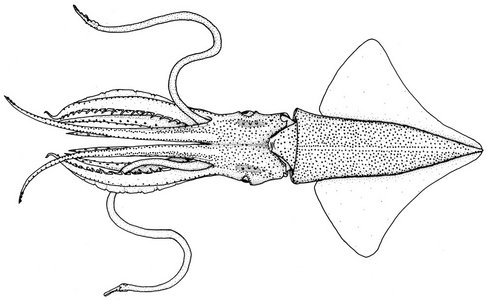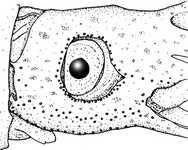Abraliopsis tui
Kotaro TsuchiyaIntroduction
A. tui is an endemic Abraliopsis species from New Zealand and Kermadec waters. Females reach about 35 mm ML and males about 30 mm ML.
Brief diagnosis:
An Abraliopsis (Abraliopsis) ...
- with central bare strip (i.e., without photophores) of Median Mantle Sector distinct virtually to anterior mantle margin.
- without a dorsal flap on the hectocotylus.
- with distinct posterior-crescent ridge connecting occipital folds 3 and 4.
Characteristics
In addition to familial characters (listed on the Enoploteuthidae page) and generic characters (listed on the Abraliopsis page), Abraliopsis tui has:- Tentacle clubs
- Two rows of Different-sized hooks on manus.
- Carpal flap and aboral keel, large.
- Arms
- Arms IV long; ALI IV = 100-110.
- Arms I-IV with 17-23 hooks and arms I-III with ca.30 distal suckers.
- Hectocotylus
- Hectocotylus with single long narrow flap along ventral margin; dorsal flap absent.
- Modified portion with armature.
- Integumental Photophores
- Ventral mantle and head with scattered arrangement of integumental organs.
- Ventral mantle and head with scattered arrangement of integumental organs.
Comments
Details of the photophore patterns are unknown.
Distribution
Geographical Distribution
This species is only known from New Zealand and Kermadec waters (Riddell, 1985).References
Riddell, D.J. 1985. The Enoploteuthidae (Cephalopoda: Oegopsida) of the New Zealand region. Fisheries Reserch Bulletin (NZ), 27:1-52.
Title Illustrations

| Scientific Name | Abraliopsis tui |
|---|---|
| Location | South Pacific just north of New Zealand |
| Reference | Riddell, D.J. 1985. The Enoploteuthidae (Cephalopoda: Oegopsida) of the New Zealand region. Fisheries Research Bulletin (N.Z. Ministry of Agriculture and Fisheries), 27:1-52, 33 figures. |
| Creator | D. J. Riddell |
| Sex | Female |
| View | Ventral |
| Size | 30 mm ML |
| Type | Paratype |
About This Page
Kotaro Tsuchiya

Tokyo University of Fisheries, Tokyo, Japan
Page copyright © 2013 Kotaro Tsuchiya
All Rights Reserved.
- Content changed 03 November 2013
Citing this page:
Tsuchiya, Kotaro. 2013. Abraliopsis tui . Version 03 November 2013 (under construction). http://tolweb.org/Abraliopsis_tui/19692/2013.11.03 in The Tree of Life Web Project, http://tolweb.org/











 Go to quick links
Go to quick search
Go to navigation for this section of the ToL site
Go to detailed links for the ToL site
Go to quick links
Go to quick search
Go to navigation for this section of the ToL site
Go to detailed links for the ToL site